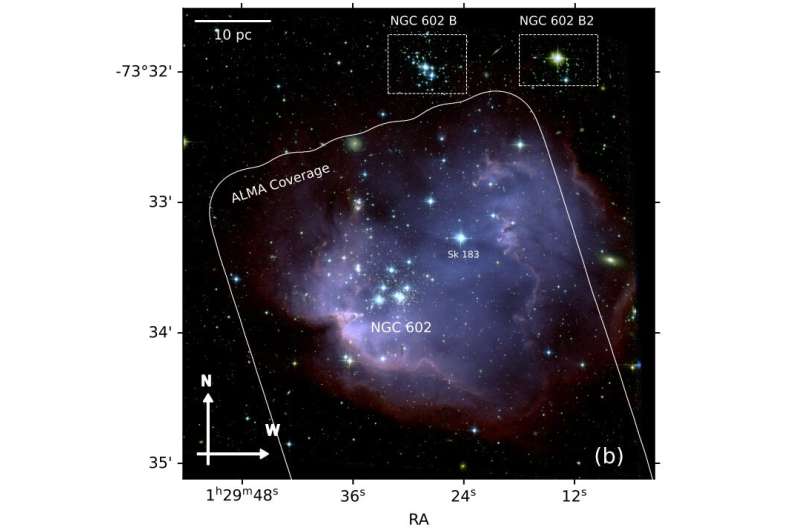September 8, 2022 report
Young open cluster NGC 602 inspected with ALMA

Using the Atacama Large Millimeter/submillimeter Array (ALMA), astronomers have investigated a young open cluster in the Small Magellanic Cloud (SMC), known as NGC 602. Results of the research, presented August 29 on the arXiv pre-print server, deliver important insights into the properties of this cluster, revealing that it experienced a sequential star formation process.
Open clusters (OCs), formed from the same giant molecular cloud, are groups of stars loosely gravitationally bound to each other. So far, more than 1,000 of them have been discovered in the Milky Way, and scientists are still looking for more, hoping to find a variety of these stellar groupings. Expanding the list of known galactic open clusters and studying them in detail could be crucial for improving our understanding of the formation and evolution of our galaxy.
At a distance of some 196,000 light years away, NGC 602 is a young, bright, low-metallicity OC in SMC. Together with its associated HII region N90, containing clouds of ionized atomic hydrogen, it is located in the "Wing" of the SMC. Due to their proximity, NGC 602 and N90 provide a valuable opportunity to examine star formation scenarios under dramatically different conditions from the solar neighborhood.
So a team of astronomers led by Theo J. O'Neill of the University of Virginia investigated NGC 602/N90 with ALMA, focusing on the nature of dense gas in N90, and the history of the region's evolution.
"We present results from ALMA observations of molecular gas in the low-metallicity star-forming region NGC 602/N90," the researchers wrote in the paper.
The observations identified over 100 molecular clumps traced by carbon monoxide (CO) emission. The clumps are arranged around the region's rim. By investigating the properties of these clumps, the astronomers estimated that a total molecular gas mass in N90 is at a level of 16,600 solar masses.
The study found that clumps in N90 generally do not agree with expected trends in size-linewidth-surface density space. Moreover, they turned out to have larger velocity dispersions and lower surface densities than predicted by relationships derived from Galactic clouds.
Furthermore, the results suggest that intermediate-mass star formation has likely been occurring throughout the N90 region in the last one to two million years. In general, the recent star-formation rate for NGC 602/N90 was calculated to be about 130 solar masses per year and the research found no strong evidence that NGC 602 has directly triggered star formation along the rim of N90.
The astronomers concluded that the properties of clumps in N90 have revealed the sequential star formation history of the region. The results also indicate that star formation in N90 is not more efficient than star formation in similarly massive solar-metallicity, higher-density environments.
More information: Theo J. O'Neill et al, Sequential Star Formation in the Young SMC Region NGC 602: Insights from ALMA. arXiv:2208.13768v1 [astro-ph.GA], arxiv.org/abs/2208.13768
© 2022 Science X Network





















